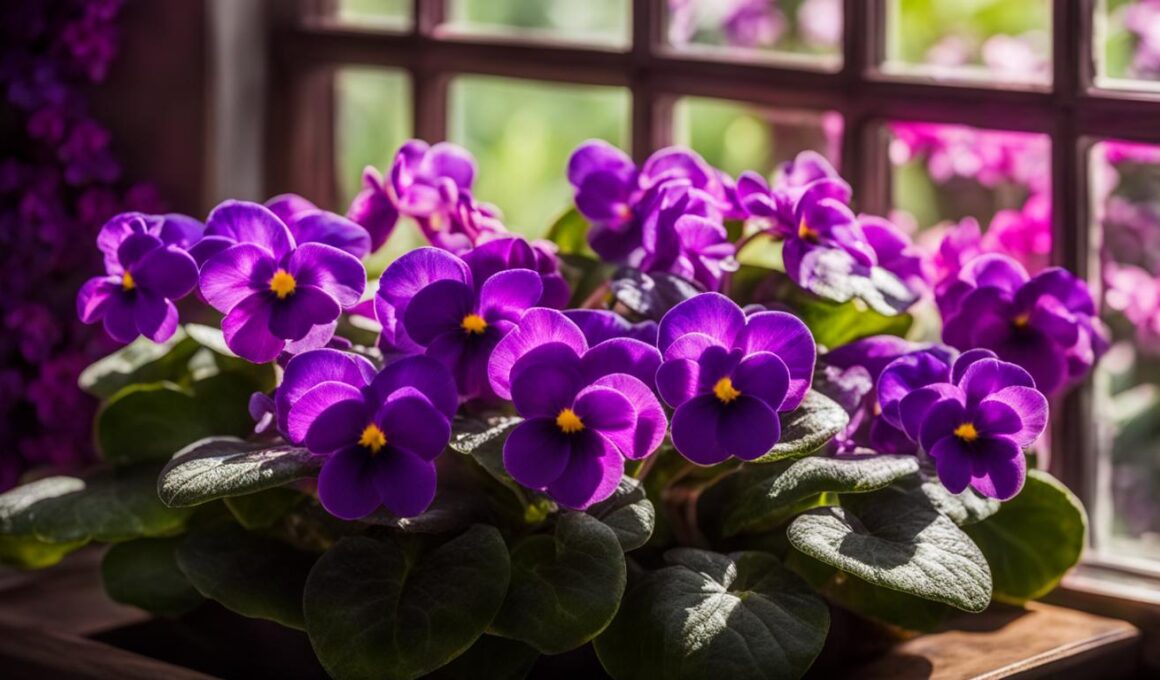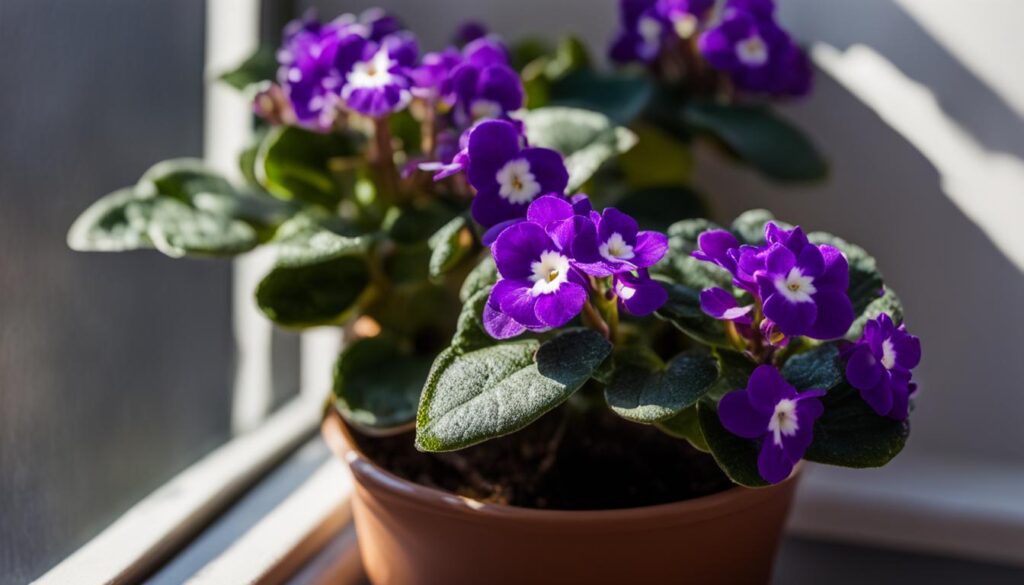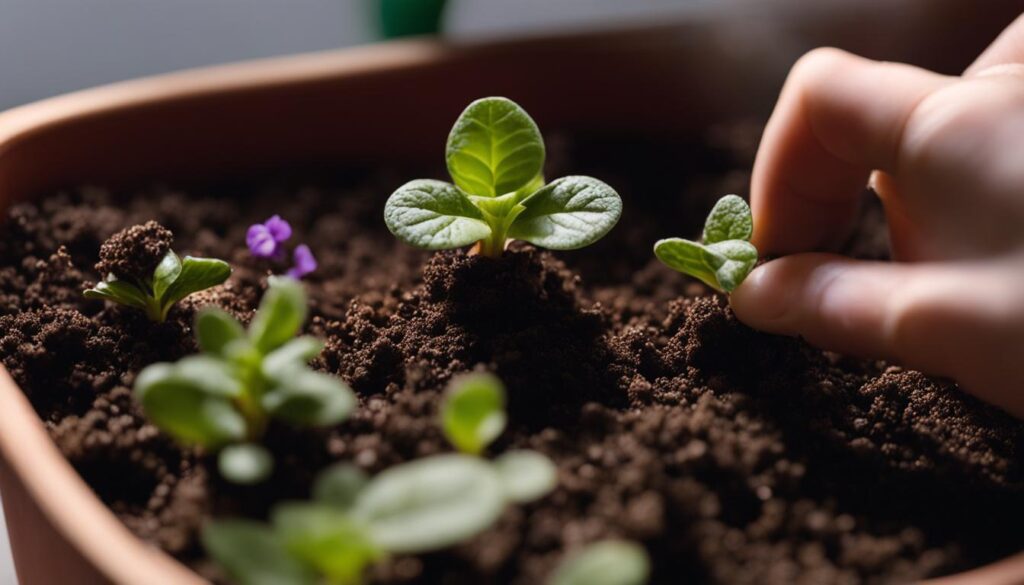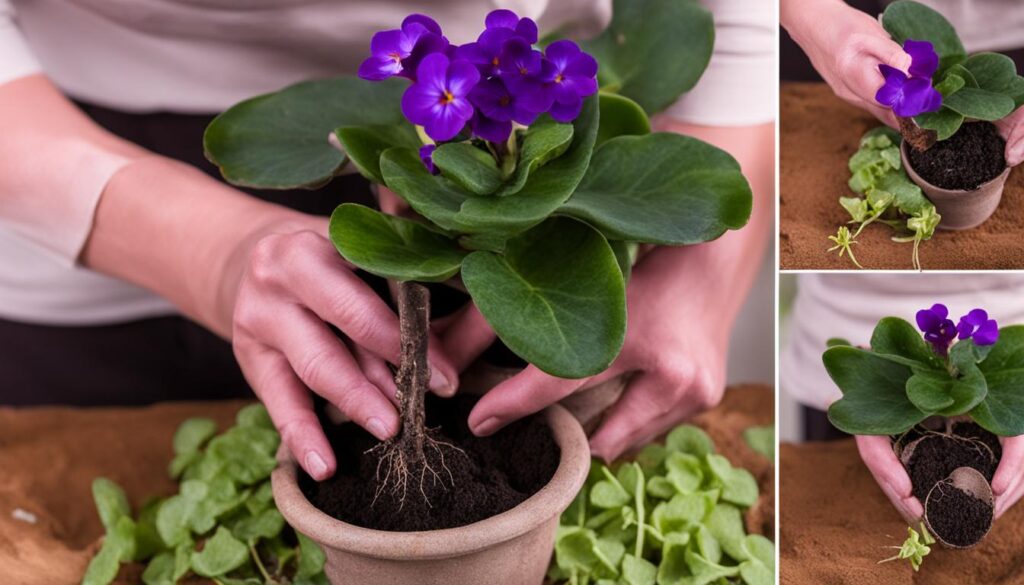As indoor flowering plants, African violets are adored for their stunning, continuous blooms and ability to flourish all year long, even during winter months. However, achieving a consistent blooming cycle requires regular care and attention to their specific needs, such as controlled temperature, optimal lighting, and appropriate nutrients. By investing time and effort into the well-being of these vibrant plants, you can experience the rewarding results of a house adorned with their colorful blossoms.
Key Takeaways
- African violets are known for their continuous bloom and adaptability as indoor flowering plants.
- These plants require dedicated care, including proper temperature, lighting, and nutrients for optimal blooming.
- Understanding African violets’ blooming cycle is key to cultivating healthy, long-lasting flowers.
- Employing the right care techniques is crucial for maximizing the plants’ blooming frequency and overall health.
- With proper care, African violets can be encouraged to produce vivid blooms throughout most of the year.
Understanding the Blooming Cycle of African Violets
The blooming cycle of African violets is a fascinating process that involves the creation of a flowering hormone known as florigen. This hormone is produced under sufficient light but triggers blooming when it’s dark, requiring periods of both light and darkness each day. With optimal care, African violets may bloom continuously for up to 10 months each year, with intervals for new flower formations.
Generally, with appropriate disbudment, new blooms could appear in 6 to 8 weeks. To better understand the factors influencing the bloomability of African violets, let’s explore the key bloom triggers and the role of rest between bloom cycles.
- Light Exposure: As mentioned earlier, florigen production requires sufficient light. African violets need consistent but indirect sunlight to encourage blooming.
- Darkness Periods: While light is essential for florigen production, darkness is needed to activate the hormone and trigger blooming. Ensure your African violets receive 8 hours of darkness each night.
- Temperature: These indoor flowering plants thrive in temperatures between 70-80°F during the day and 65-70°F at night. Deviating from these preferred conditions can impact the blooming process.
Another vital aspect of the African violet bloom cycle is a period of rest between bloom cycles. Just as humans need rest to function at their best, these flowering plants benefit from a brief intermission between blooms. Rest periods allow the plants to channel their energy into producing new flowers, leading to a more abundant and colorful display.
In summary, understanding and respecting the African violet bloom cycle, with proper attention to bloom triggers and rest between bloom cycles, significantly enhances the chances of achieving continuous and vibrant blooms for these delightful indoor flowering plants.
Essential Care Tips for Encouraging African Violet Blooms
To ensure prolific blooming of your African violets, it is essential to understand and meet their specific light requirements, maintain optimal temperature conditions, and provide proper watering techniques. In this section, we’ll dive into these essential care tips designed to help your African violets thrive and produce vibrant blooms.
Optimizing Light to Trigger Blooming
African violets require bright, indirect sunlight to bloom effectively. East- or north-facing windows are ideal as they receive adequate sunlight without causing damage to their delicate leaves. Direct sunlight can scorch the foliage and harm the plant. On the other hand, insufficient light can prevent flower production. In instances where there’s not enough sunlight, consider supplementing your African violets with grow lights for 12-14 hours a day. Additionally, it is crucial for them to receive at least 8 hours of darkness each night to activate the flowering hormone florigen and trigger blooming.
Maintaining the Ideal Temperature for African Violets
A stable, moderate temperature is essential for African violets to thrive and bloom consistently. Your indoor flowering plant requires a daytime temperature ranging from 70-80°F and a nighttime temperature of around 65–70°F. Maintaining these temperature ranges promotes active growth and flowering, while deviations can stress the plants and inhibit blooming. Be vigilant of your plant’s surroundings and temperature impacts on blooming to create a comfortable environment for your African violets.
Watering Techniques for Healthy Blooms
Proper watering is critical for maintaining African violet health and promoting blooming. These plants prefer even moisture, akin to a well-wrung sponge. It is essential not to let them dry out completely or remain overly damp, as over-watering can lead to root rot, while under-watering can cause bloom failure. To strike a balance, adopt the following watering technique:
- Fill the saucer under the plant with water.
- Allow it to sit for an hour, enabling the plant to absorb the necessary moisture.
- Empty the excess water from the saucer to avoid waterlogging and potential root damage.
- Allow the plant to dry out between watering sessions, ensuring an ideal moisture balance for blooms
By adhering to these essential care tips, you’ll create a nurturing environment for your African violets to thrive and bloom, providing splashes of color and excitement to your indoor living spaces.
The Role of Fertilization in African Violet Flowering
Providing the right nutrients through African violet fertilization plays a crucial role in promoting flowering and maintaining healthy growth. Unlike outdoor plants that obtain nutrients from the soil, indoor African violets rely entirely on the grower for their nutrient supply, particularly since they thrive in small pots with a limited soil volume.
Incorporating a balanced fertilizer that supplies the proper nutrients in the required amounts is essential for achieving robust blooms. Ideally, the selected fertilizer should have a higher phosphorus content in comparison to nitrogen. Phosphorus encourages flowering, while excess nitrogen can lead to excessive leaf growth at the expense of blooms.
It is essential to avoid fertilizers containing urea, which can cause root damage in African violets. Instead, opt for well-recommended products like Espoma’s liquid Violet! Indoor houseplant food or other fertilizers formulated specifically for these plants to ensure they receive the necessary NPK (Nitrogen, Phosphorus, Potassium) nutrients for optimal growth and flowering.
To promote continuous flowering, it is vital to establish and maintain a consistent feeding frequency. Fertilize your African violets every 2 to 4 weeks during their growing seasons. However, be cautious not to over-fertilize, as doing so can cause nutrient imbalances and negatively affect plant health and flowering. In addition, it is good practice to flush the soil with water occasionally to prevent the buildup of salts from fertilizers.
Aside from the NPK nutrients, African violets also benefit from the presence of essential micronutrients in their fertilizer. These include Iron (Fe), Magnesium (Mg), Manganese (Mn), and others that play crucial roles in the overall plant health and flowering process.
- Choose a fertilizer with a higher phosphorus content than nitrogen.
- Avoid fertilizers containing urea.
- Opt for well-recommended products like Espoma’s liquid Violet! Indoor houseplant food
or other African violet-specific fertilizers. - Fertilize your African violets every 2 to 4 weeks during their growing seasons.
By providing the right flowering nutrients in a balanced formulation, and maintaining a consistent feeding schedule, you can support your African violets in their quest for optimal growth and prolific blooming throughout the year.
Repotting African Violets: Timing and Techniques
Although African violets bloom best when they are root-bound, repotting becomes necessary once they outgrow their current container. In this section, we will discuss the timing and techniques for repotting African violets as well as the benefits of keeping them root-bound.
Choosing the Right Pot Size for African Violets
Selecting the proper pot size for your African violet is crucial in encouraging a healthy bloom. The ideal pot size should be about a third of the diameter of the plant’s leaf spread. Common pot sizes range from 2 inches for plantlets to up to 4 inches for larger plants. Always ensure that the pot you choose has adequate drainage holes to prevent water buildup and root issues.
When repotting, use an organic African violet potting mix to provide the necessary nutrients and drainage for your plant. The following table highlights ideal pot sizes based on the diameter of the plant’s leaf spread:
| Leaf Spread Diameter | Pot Size |
|---|---|
| Up to 6 inches | 2 inches |
| 6-12 inches | 3 inches |
| 12-18 inches | 4 inches |
Repotting should generally be performed once a year, usually during the spring or early summer, when the plant is actively growing. This can help the plant to adjust to the new pot more quickly.
- Gently remove the African violet from its current pot, being careful not to damage the roots.
- Examine the root system for any signs of damage or decay. If you find any, trim away the damaged parts with a clean pair of scissors to ensure a healthy root system.
- Prepare the new pot by filling it about halfway with fresh, organic potting mix specifically formulated for African violets.
- Place the African violet in the new pot, positioning it at the same depth as it was in the previous pot. This ensures that the crown of the plant is not buried, which could lead to rotting.
- Fill the remaining space around the plant with potting mix, gently firming it in place to secure the plant. Avoid packing the soil too tightly, as this can inhibit root growth.
- Water the plant thoroughly to help it settle into the new pot and encourage root growth. This also ensures that the potting mix is evenly moist throughout.
By repotting African violets when necessary and using the proper pot size and organic potting soil, you can promote healthy growth and vibrant blooms for these beautiful indoor flowering plants.
Will Propagating Plumeria Affect the Blooming Frequency of African Violets?
Propagating plumeria success guide does not impact the blooming frequency of African violets. Each plant has its own unique needs and requirements for blooming. Proper care and maintenance, such as proper watering and light exposure, are more influential factors in the blooming frequency of African violets.
Conclusion: Cultivating Continuous Blooms in African Violets
Achieving continuous blooms in African violets is not only possible but can be a rewarding experience for any indoor gardener. By focusing on indoor plant care essentials, such as optimizing light exposure, maintaining comfortable temperatures, employing effective watering strategies, regular fertilization, and choosing the right time and method for repotting, you can enjoy spectacular blooms throughout most of the year.
These healthy flowering practices not only allow African violets to flourish but also play a significant role in enhancing the beauty of your indoor spaces with their vibrant flowers and velvety foliage. As you implement these methods, you’re bound to see a noticeable improvement in the blooming frequency of your plants.
Remember that patience and consistent care are key to success in reblooming African violets time and again. With a keen eye on your plants’ needs and a dedicated approach to maintaining their optimal growth conditions, you’ll soon have thriving, beautiful blooms that liven up any room. Enjoy the journey of perfecting the art of nurturing your African violets, and reap the bountiful rewards in the form of continuous African violet blooms.












